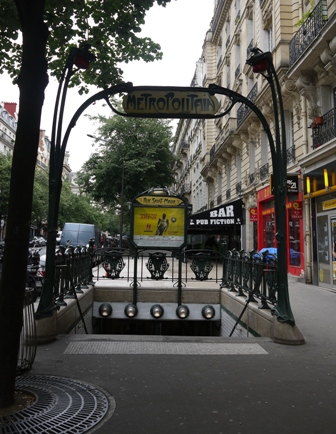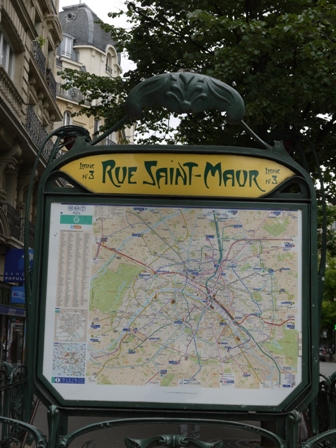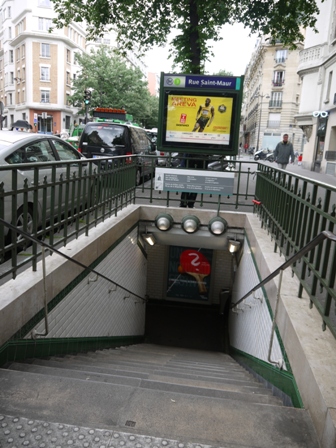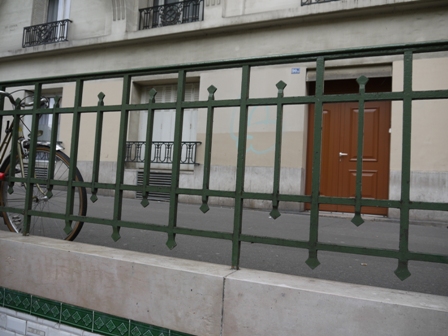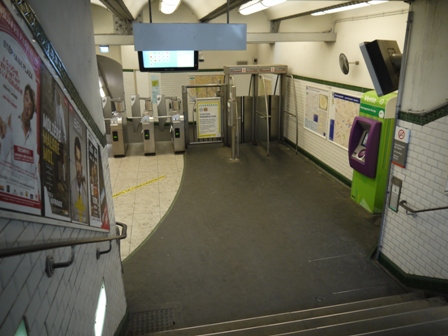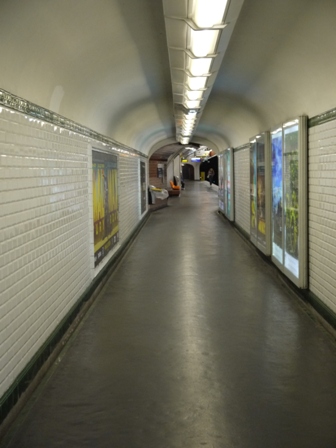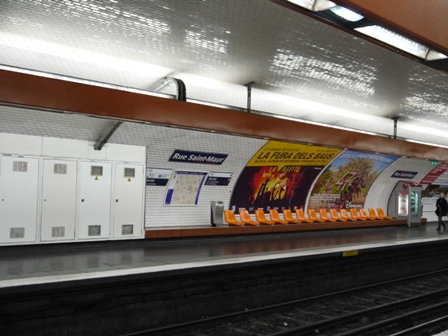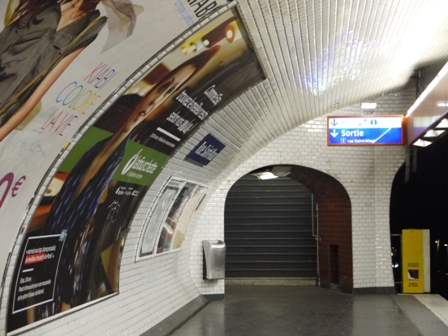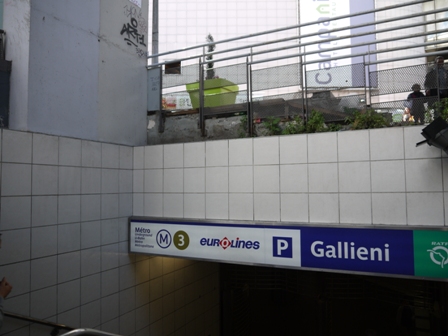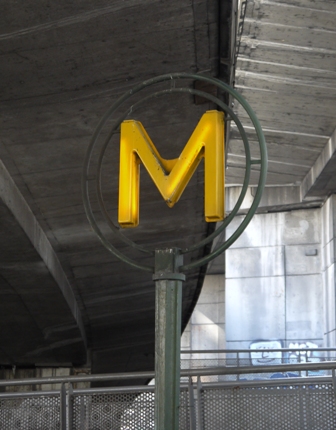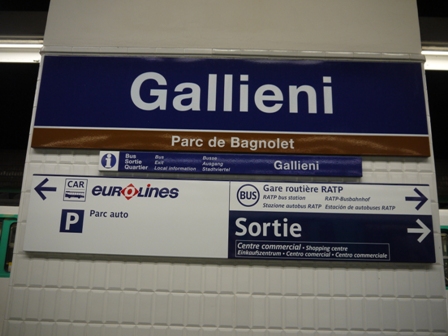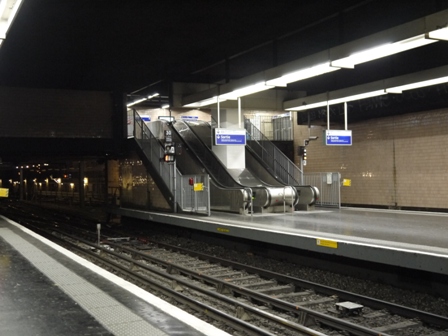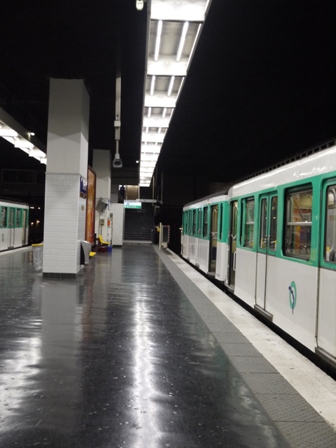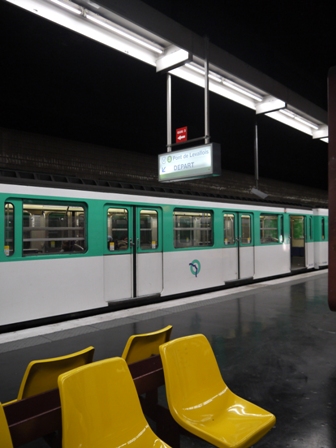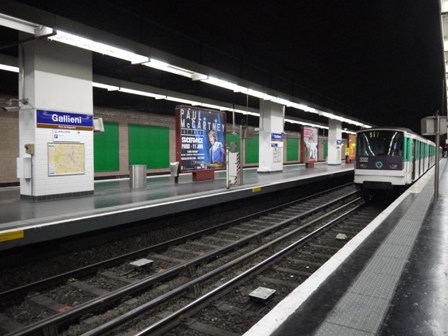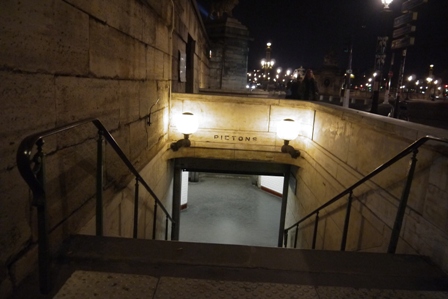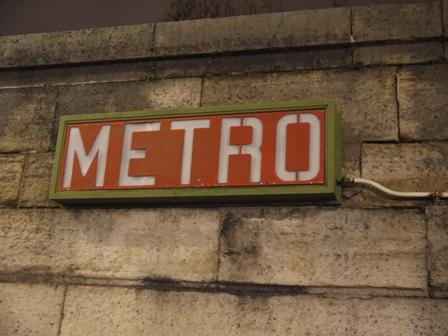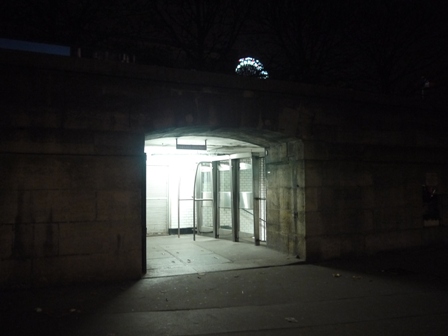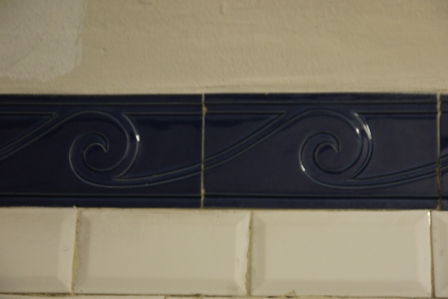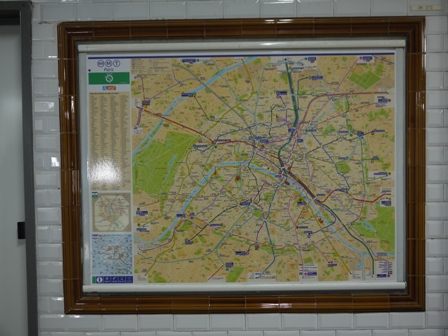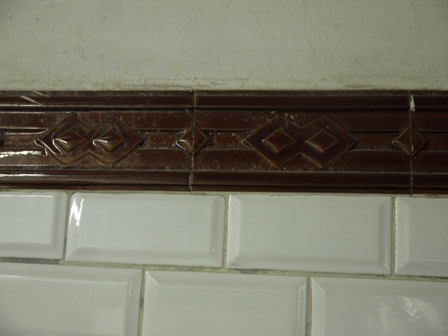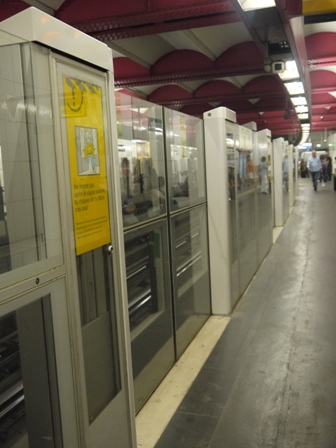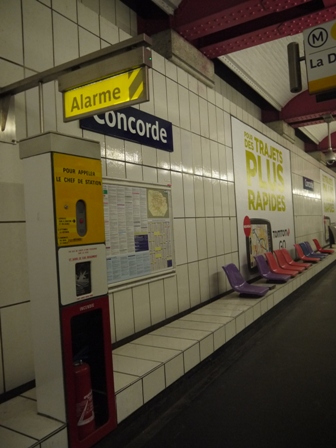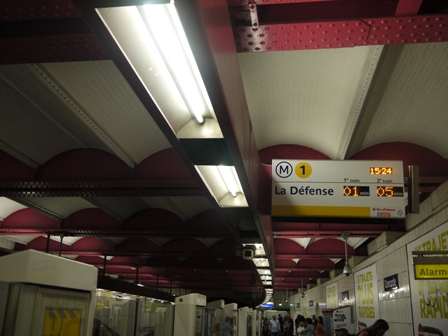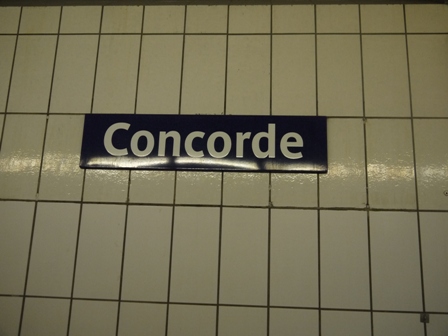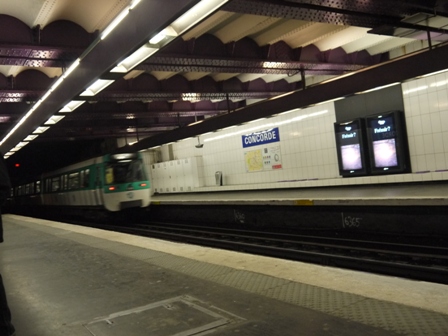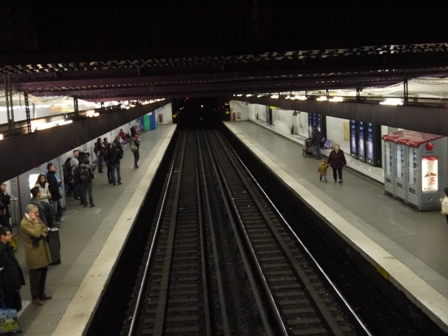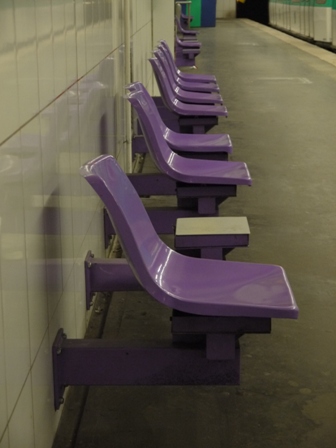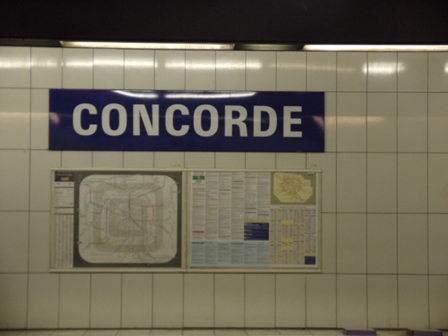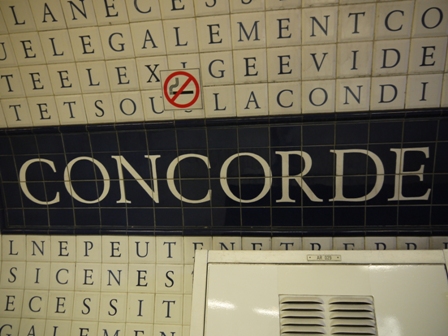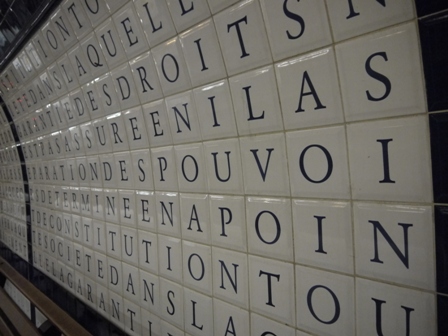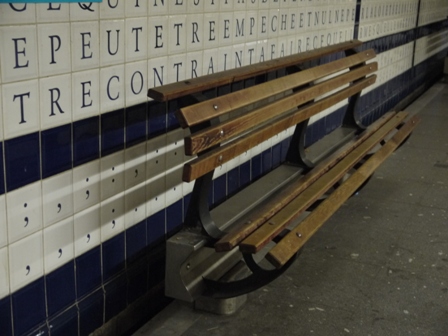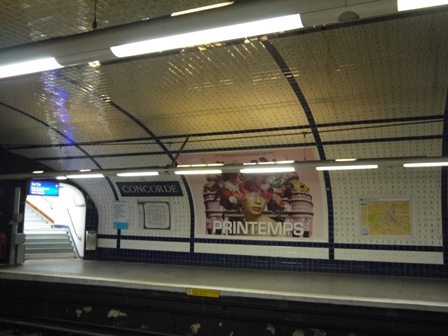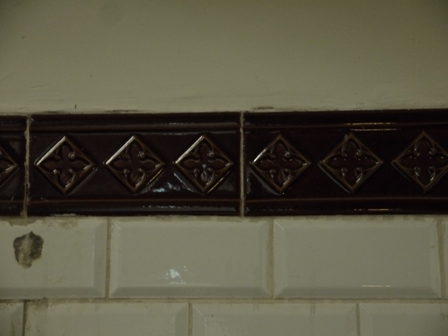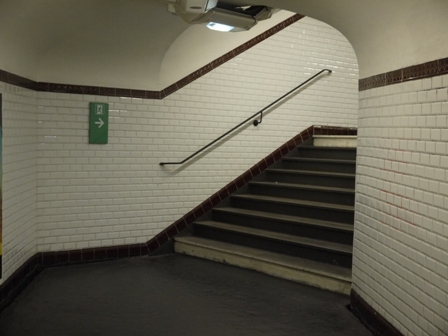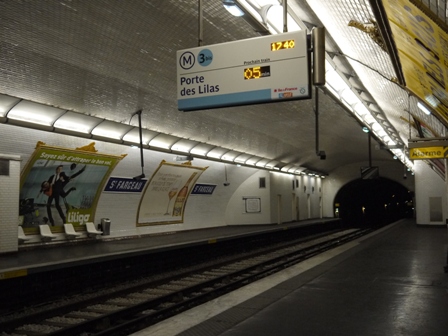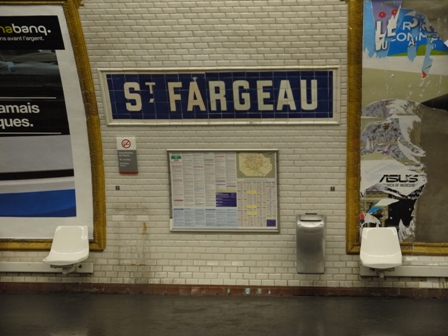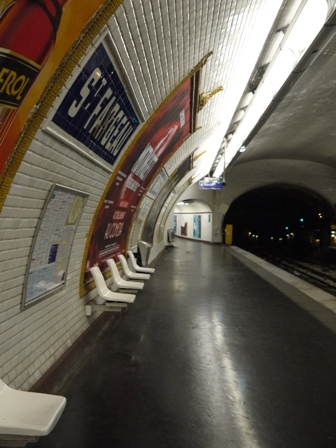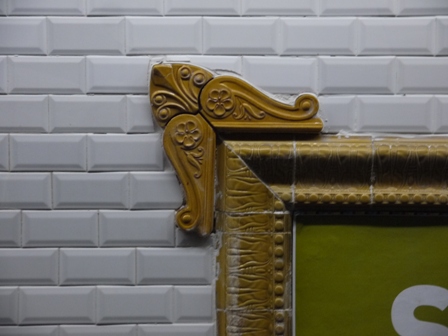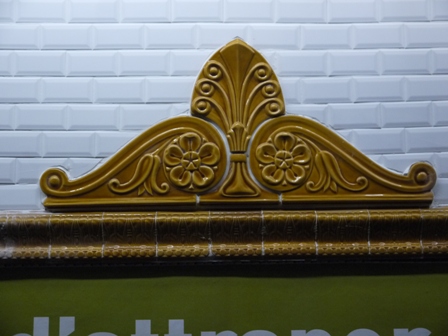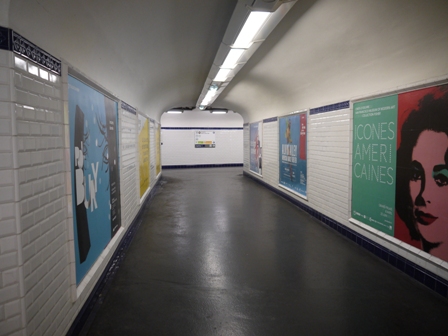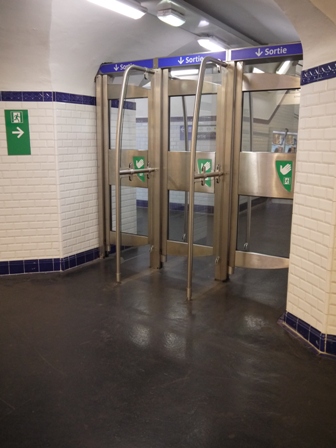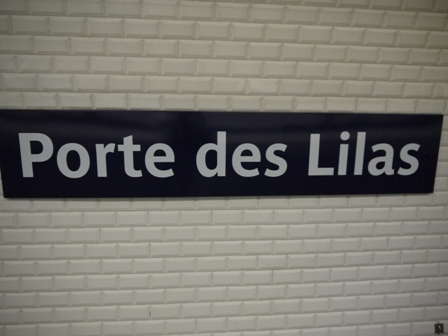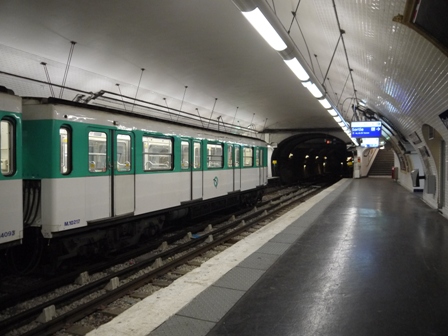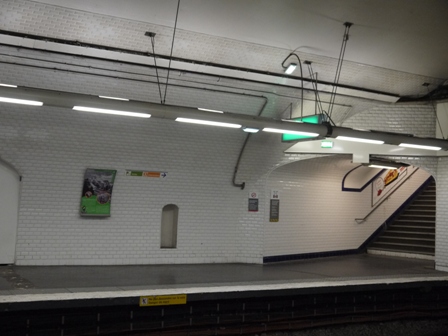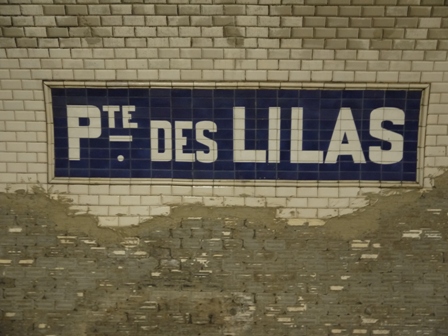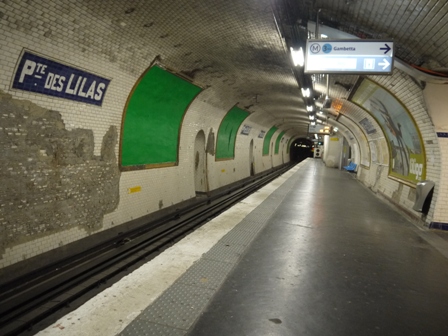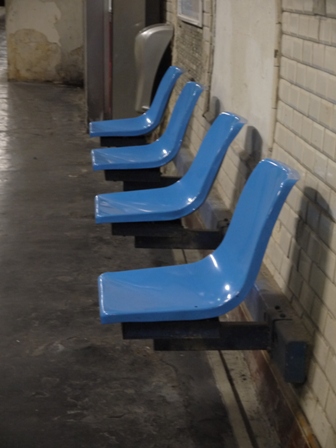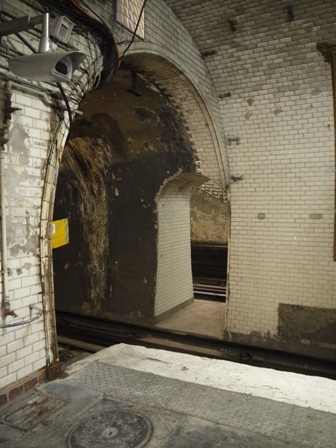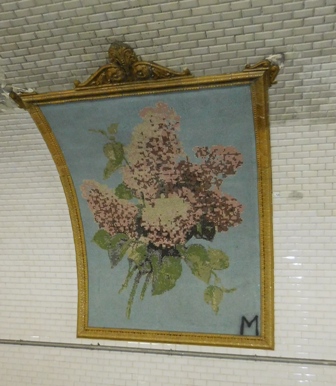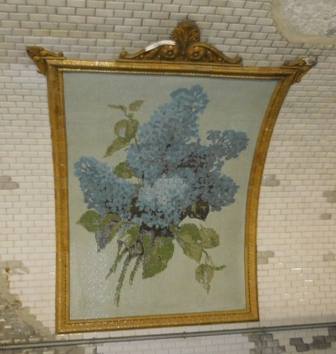- Details
The station opened on 19 October 1904 as Saint-Maur. It changed its name to Rue Saint-Maur on 1 September 1998 in order not to confuse it with a station on the RER A in the community of Saint-Maur-des-Fossés.
The station is named after Saint Maurus, a Benedict monk who saved the life of Saint Placide.
It is situated in the 11th arrondissement. It is served by the metro line 3.
The main entrance to the station is in the art nouveau style. The "Metropolitain" sign arches over the stairs. The posts are flower-shaped with red lights.
On the ground underneath the lampposts a wide white row of raised plasticised circles to mark the top of the stairs.
Five round lamps are placed over the entrance at ground level. They are in green metal holders.
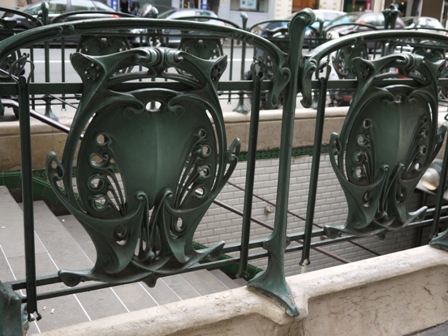
The fence is made of large cast-iron panels designed by Hector Guimard. They too are in the art nouveau style showing flowing forms based on nature.
The panels are painted matt green.
Station sign and lamp over a map of the metro network.
The station name is spelled in green on a yellow background with an art nouveau typeface.
The second entrance goes straight to the platform.
It has a modern panel with advertising, the station name and the number of the line serving it.
Three round lamps are placed over the entrance at ground level. A sign above the lamps indicates that the entrance is only for valid ticket holders.
On top of the stairs is a row of grey nobbed tiles, but it is not highlighted in white.
Metal handrails have been fixed to both side walls.
The iron fence is plain green, with bars of different lengths.
Steps to the ticket hall. At the right is the machine to buy tickets and recharge the Navigo.
The two silver exit doors open in the middle.
Corridor from the secondary entrance to the platform. The curved ceiling is painted white.
Some advertising boards have white ceramic borders, but most are in separate frames mounted on the wall. They are lit from behind.
The border tiles are green flowers.
The curved ceiling of the platform is tiled. The tiles reflect the light.
A long row of orange plastic chairs is mounted on orange tiles. The lights are in matching orange metal boxes above the edge. This style is called Andreu-Motte.
The advertising behind is in metal frames.
The edge of the platform is marked in white, with no additional yellow line. A row of about 20 cm wide nobbed tiles has been added to warn sight-impaired travellers of the edge.
The station name is printed in white upper and lower case letters on a blue plastic sign.
Entrance to the platform is from the end.
The tiles in the arch are orange.
The walls are curved all the way to the ground. So the advertising boards are curved as a result.
- Details
The station opened on 2 April 1971. It is named after General Joseph Gallieni (1849 - 1916), military commander and administrator in Africa, and Military Governor of Paris during World War I.
The station is situated in the community of Bagnolet.
It is the eastern terminal of the metro line 3.
The station is built under a large shopping centre and next to an international bus station.
The tiles around the entrance are square and white. The station name and the metro line are fixed on the wall above the entrance. The entrance also leads to some parking.
The large yellow M in a double circle on a posts indicates the entrance from further away. It is lit at night. This style of post became the standard in the 70s.
Above it are the pavements of the shopping centre.
Signage on a pillar in the centre platforms. The name is painted in mixed case, white letters on blue enamel. Underneath is the reference to the Parc de Bagnolet as a sub-name in white smaller type on a brown background.
The tiles on the pillar are matt white with a raised centre and placed vertical.
Escalators and stairs to the third platform.
The walls are tiled in light brown rectangular tiles, placed horizontal.
Centre platforms with metro.
The ground is painted grey.
The edges of the centre platforms are painted white with another row of grey tiles with raised knobs.
The sign indicating which platform the next metro is leaving from is suspended from the light casings. It points to the waiting metro.
Close by are some yellow plastic seats fixed to the ground to give passengers a place to rest.
View from platform over the tracks. The edge of the platform is marked with a thin white stripe.
About 30 cm from the edge is a strip of nobbed tiles roughly the same width.
Some advertising panels are placed on the far away wall.
- Details
The underground station opened on 13 August 1900 with the start of operating the line 1.
It is situated at the intersection of the 1st and 8th arrondissements on the place de la Concorde. It is served by the metro lines 1, 8 and 12.
Entrance to the Concorde station from rue Rivoli. The stones are an extension of the wall around the Tuileries. Two lamps on a brass arm are place in the corner above the frame. The entrance is labelled as PIETONS - pedestrians. There are no signs for metro or metropolitain outside.
Lit metro sign on the wall. The letters METRO are cut out of a red background, showing the white light.
Exit from the station toward rue Rivoli. The glass doors lead into a well lit area under part of the Tuilerie Gardens.
The border tiles in the corridor towards the line 12 are dark blue with a raised wave pattern. The tiles are smooth otherwise.
Below are white tiles in the metro style.
Map of the metro and tram network in a brown ceramic frame.
The chocolate brown border tiles in the corridor has single and double diamont shapes. The geometric shapes are set on a centre ridge.
Platform line 1
Line 1 started operation on 13 August 1900. The line is now fully automated.
Platform separation doors have been installed on the line 1. A white line has been painted on the ground where the doors open.
The doors open automatically after a metro train has arrived.
The floor is painted grey.
The walls are tiled in large, white flat tiles which have been placed vertical. The same tiles have been used to build a base for the purple and pink plastic seats. An emergency call point is close by to call the station master.
The advertising posters are in metal frames, stuck close to the wall.
As on the platform of the line 1, you can see the iron structure above. It is painted red.
The metal light casings are red in the Andreu-Motte style.
The electronic display shows the line, the current time and the waiting time until the next two trains.
The signage is in white upper- and lower case letters on a blue background.
Platform line 8
Line 8 started operation 12 March 1914.
The ceiling of the platform is supported by steel girders painted purple. It has several small arches to give it more strength.
The edge of the platform has a broad white line and nobbed tiles, but no yellow line.
Advertising is in large digital frames.
View from the link bridge over both platforms. The platforms are on either side of the tracks.
On the platform to the right - direction Balard - the seats are fixed on a base of white tiles, although not many seats remain.
Purple plastic seats are fixed along the wall of the platform direction Creteil. The comfortable seats are declined slightly.
The signage on platform 8 is in capital white letters on a blue enamel sign. The sign is fixed on large white rectangular tiles, which are fixed vertical.
Below the sign is a metro plan with the zones and the transport rules.
Platform line 12
Line 12 started operation on 5 November 1910. In 1991 the platform was refurbished with square white tiles and blue lettering holding the text of the Human Rights Declaration.
The station name is stencilled in narrow uppercase letters on square dark blue tiles, which are surrounded by a blue frame.
The text of the human rights declaration is continous without spaces or signs. The signs are collectively placed at the bottom.
The narrow wooden slatted bench has a double bend.
Entrance to the platform is from the end. The curved ceiling is tiled. The text of the declaration stretches from one platform to the other. It is devided in sections by blue tiles. Advertising is in a white ceramic frame. The silver lights are suspended from the ceiling.
- Details
The station opened on 27 November 1921.
It is situated in the 20th arrondissement. The station is named after the statesman Louis-Michel Lepeletier de Saint-Fargeau (1760 -1793).
It is today served by the metro line 3bis. The line was renamed 3bis on 27 March 1971, when the line 3 was extended in the direction Gallieni.
Brown border tiles with flowers.
Corridor and stairs to the platform. The walls are tiled in white with brown tiles at the floor level and top.
The tracks are between the two platforms.
The display panel shows the current time and the time to the next train. (Trains on main lines show the next two trains).
The vaulted ceiling is tiled.
The lights are placed in a row of colon shaped metal casings along the ceiling. The uplight is reflected on the top of the casings.
Platform signage stencilled on dark blue, square tiles in a white ceramic frame.
Underneath the sign are the general metro transport regulations, a small network diagram and the times of the first and last trains per station.
The non-smoking sign is in French, English and Spanish.
Access to the platform direction Porte des Lilas is from the end of the platform.
White plastic seats are fixed under advertising frames.
The white tiles are in the "Metro" style.
Advertising is in large ceramic frames with wheat pattern. The top corners and edge have some decorative tiles.
The corner elements of the brown advertising frames are made of three parts. The long tiles have a an open flower, a semi-open flower and a scroll. The flowers are different from the one found on some of the other platforms. The centre tile is a fern with four furled leaves.
The top ornament is also constructed of three parts. It uses the two long tiles from the corner ornament around a larger leaf-shaped tile.
- Details
Porte des Lilas opened on 27 November 1921.
The station is situated on the border of the 19th and 20th arrondissements, at one of the former defensive walls built around Paris between 1841 and 1844.
It is today served by the metro lines 3bis and 11. It is a terminus for the line 3bis.
Corridor from the platforms of the line 3bis. The white tiles are topped by a frieze of dark blue flowers.
Advertising is in white ceramic frames.
Metal and glass push doors on the inner exit of the station. The doors open to the right.
Platform Line 3bis
Line 3bis started operation on 27 November 1921 as the line 3. It was renamed 3bis on 27 March 1971, when the line 3 was extended in the direction Gallieni.
The signage is a blue sign with white lower and upper case letters, mounted on white tiles of the Metro style (small ceramic tiles with raised centres).
Metro at the platform and tunnel towards Saint-Fargeau.
The edge of the platform is marked in white, with no additional yellow line. A row of about 20 cm wide nobbed tiles has been added to warn sight-impaired travellers of the edge.
Platform and entrance at the end of the platform.
The walls are tiled, the vaulted ceiling is painted.
Lights in grey encasings are hung from the ceiling fixed in intervals by two wires.
Platform Line 11
Line 11 started operation on 28 April 1935. Presently the platform is being completely restored. Hence it looks very untidy just now.
Signage on the line 11. "PTE DES LILAS" is stencilled in capitals on dark blue, rectangular tiles in a white ceramic frames. Broken tiles have been removed.
Platform in direction Mairie des Lilas. The other platform is separated by a tiled wall with walk-through arched openings.
Advertising is in brown ceramic frames with decorations. The frames on the platform side are used, the ones on the separating walls are blank.
The ceilings are tiled.
Access to the platform is from the side. The edge of the platform is marked by a white line and a row of nobbed tiles.
Blue plastic seats fixed on a bar on the wall.
Tunnel from direction Télégraphe and arch through the wall to the tracks in the other direction.
On the walls of the platform direction Paris are three mosaics in ceramic frames. Two of them show flowers, namely Lilac (= lilas).
The first one shows some light coloured lilac branches on a blue background.
Mosaic of blue lilac in a light brown ceramic frame.

